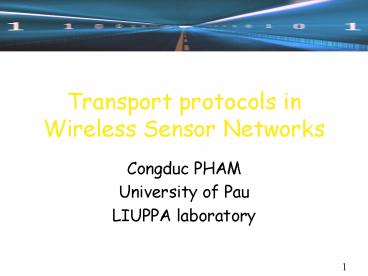Transport protocols in Wireless Sensor Networks - PowerPoint PPT Presentation
Title:
Transport protocols in Wireless Sensor Networks
Description:
Transport protocols in Wireless Sensor Networks Congduc PHAM University of Pau LIUPPA laboratory Transport layer for WSN/WMSN Reliability/loss recovery Congestion ... – PowerPoint PPT presentation
Number of Views:76
Avg rating:3.0/5.0
Title: Transport protocols in Wireless Sensor Networks
1
Transport protocols in Wireless Sensor Networks
- Congduc PHAM
- University of Pau
- LIUPPA laboratory
2
Transport layer for WSN/WMSN
- Reliability/loss recovery
- Congestion control
- Congestion detection
- Fairness issues
- Higher semantic than packet level
- Multipoint communication
- Data aggregation, data dissemination
3
Congestion Control
Closed-loop control
- Feedback should be frequent, but not too much
otherwise there will be oscillations - Can not control the behavior with a time
granularity less than the feedback period
4
TCP congestion control
From Computer Networks, A. Tanenbaum
- cwnd grows exponentially (slow start), then
linearly (congestion avoidance) with 1 more
segment per RTT - If loss, divides threshold by 2 (multiplicative
decrease) and restart with cwnd1 packet
5
WSN vs Internet
- Small fraction of time dealing with impulses, but
data of greatest importance! - As in wireless transmission, difficult to
distinguish congestions from node failures or bad
channel quality - Sensors have limited resources
- Simplicity in congestion detection and control
algorithms - Great interest of in-network processing
hop-by-hop CC more efficient than E2E? - WSN are collaborative in nature. Fairness issues
less important?
6
Reference architecture
7
CC scenario in WSN
- Densely deployed sensors
- Persistent hotspots
- Congestion occur near the sources
- Sparsely deployed sensors, low rate
- Transient hotspots
- Congestion anywhere but likely far from the
sources, towards the sink - Sparsely deployed sensors, high rate
- Both persistent and transient hotspots
- Hotspot distributed throughout the network
8
Some ideas for CC in WSN
- Congestion detection
- Monitor buffer/queue size
- Monitor channel busy time, estimate channels
load - Monitor the inter-packet arrival time (data,
ctrl) - Congestion notification
- Explicit congestion notification in packet
header, then broadcast (but then
energy-consuming!) - Congestion control
- Dynamic reporting rate depending on congestion
level - In-network data reduction techniques (agressive
aggregation) on congestion
9
TCP or UDP?
- TCP
- Connection-oriented, 3-way handshake
- Assumes segment losses results from congestion
- E2E reliability, congestion mechanism
- Fairness as a function of RTT
- UDP
- No flow control nor congestion control
- No reliability
10
TCP or specialized approach?
- TCP with appropriate modifications is better than
UDP is standardized protocols are to be used. - Specialized approaches
- allow for a specific preference between
reliability and congestion control - Application awareness is also possible
11
Proposals for WSNs
- ESRT
- CODA
- PSFQ
- RMST
- HDA
- GARUDA
- SenTCP
- STCP
See the reference section for complete references
of the papers
12
Which CC for WMSN? (1)
- WSN scalar data
- Wireless Multimedia Sensor Networks add video,
audio for - Enlarging the view
- Field of View of single camera is limited
- Multiples camera overcome occlusion effects
- Enhancing the view
- Can help disambiguate cluttered situations
- Enabling multi-resolution views
13
Which CC for WMSN? (2)
- Reliability should be enforced at the packet
level - Some packets are more important than others in
most of video coding schemes - Collaborative in-network processing
- Reduce amap the amount of (redundant) raw streams
to the sink
14
Related projects
- SensEye, UMass
- http//sensors.cs.umass.edu/projects/senseye/
- Cyclops, UCLA
- Panoptes, Portland State University
- VSAM team at Carnegie Mellon Univ.
15
Test-case in TCAP
Grid-based localization?
Lower priority, backup sensor?
16
Design issues directions
- Cross-layering
- Use low-level information
- Collaborative in-network processing
- Distributed algorithms
- Router-assisted, node-assisted, ad-hoc
- Simple congestion detection mechanism































